Dive Destinations
Liveaboards
Resorts / Day Trips
Scuba Training
Indonesia is one of the world's most diverse and sought-after scuba diving destinations, offering everything from vibrant coral reefs and massive schools of fish to thrilling encounters with manta rays, whale sharks, and even rare critters like pygmy seahorses and rhinopias. Spanning across the heart of the Coral Triangle, Indonesia boasts some of the richest marine biodiversity on the planet, making it a bucket-list destination for divers of all levels.
With thousands of islands and countless dive sites, Indonesia offers 2 main ways to explore its underwater treasures. Multi-day liveaboards diving expeditions are the best way to access remote, world-class dive destinations such as Raja Ampat, Komodo, Alor, the Banda Sea, and the Forgotten Islands. Whereas resort-based diving is ideal for those who prefer land-based accommodations while diving stunning locations like Bali, North Sulawesi (Lembeh and Bunaken), and Wakatobi, offering everything from muck diving to pristine coral walls.
This page covers everything you need to know about diving in Indonesia, from the best dive sites and seasons to choosing between liveaboards and resorts. Whether you're a macro photography enthusiast, a drift dive adrenaline-seeker, or someone looking for a mix of adventure and relaxation, this guide will help you plan your perfect Indonesian diving experience.


Customer rating: Excellent!

Customer rating: Excellent!

Customer rating: Excellent!

Customer rating: Excellent!

Customer rating: Excellent!

Customer rating: Excellent!

Customer rating: Excellent!

Customer rating: Excellent!

Customer rating: Excellent!

Customer rating: Excellent!

Customer rating: Excellent!

Customer rating: Very good!

Customer rating: Very good!

Customer rating: Very good!

Customer rating: Very good!

Customer rating: Very good!

Customer rating: Very good!

Customer rating: Very good!

Customer rating: Very good!

Customer rating: Very good!

Customer rating: Very good!

Customer rating: Good

Customer rating: Good

Customer rating: Good

Customer rating: Good

Customer rating: Good

Customer rating: Average

Customer rating: Be first to rate!

Customer rating: Be first to rate!

Customer rating: Be first to rate!

Customer rating: Be first to rate!

Customer rating: Be first to rate!

Customer rating: Be first to rate!

Customer rating: Be first to rate!

Customer rating: Be first to rate!

Customer rating: Be first to rate!
 Bastianos Lembeh Resort
Bastianos Lembeh Resort
Customer rating: Excellent!
 Lembeh Resort
Lembeh Resort
Customer rating: Excellent!
 Sorido Bay Resort
Sorido Bay Resort
Customer rating: Excellent!
 Tulamben Wreck Divers
Tulamben Wreck Divers
Customer rating: Excellent!
 Bastianos Bunaken Resort
Bastianos Bunaken Resort
Customer rating: Very good!
 Bunaken Cha Cha Resort
Bunaken Cha Cha Resort
Customer rating: Very good!
 Tasik Ria Dive Resort
Tasik Ria Dive Resort
Customer rating: Very good!
 Bali Island Dive Daytrips
Bali Island Dive Daytrips
Customer rating: Good
 Kri Eco Resort
Kri Eco Resort
Customer rating: Good
 Kubu Indah Resort
Kubu Indah Resort
Customer rating: Good
 Lembongan Dive Day Trips
Lembongan Dive Day Trips
Customer rating: Good
 Misool
Misool
Customer rating: Good
 Siddhartha Dive Resort
Siddhartha Dive Resort
Customer rating: Good
 TWD Villas
TWD Villas
Customer rating: Good
 Agusta Eco Resort
Agusta Eco Resort
Customer rating: Be first to rate!
 HamuEco Dive Resort
HamuEco Dive Resort
Customer rating: Be first to rate!
 Manado Dive Daytrips
Manado Dive Daytrips
Customer rating: Be first to rate!
 Meridian Adventure Dive
Meridian Adventure Dive
Customer rating: Be first to rate!
Fast e-mail response to our questions and inquiries. We had 2 trips booked to 2 different operators and you planned the best one for the end and not for the beginning and that was clever
